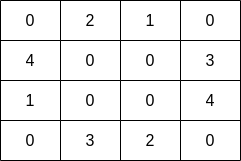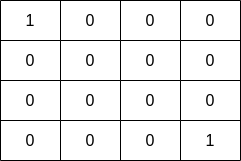2658. Maximum Number of Fish in a Grid
Description
You are given a 0-indexed 2D matrix grid of size m x n, where (r, c) represents:
- A land cell if
grid[r][c] = 0, or - A water cell containing
grid[r][c]fish, ifgrid[r][c] > 0.
A fisher can start at any water cell (r, c) and can do the following operations any number of times:
- Catch all the fish at cell
(r, c), or - Move to any adjacent water cell.
Return the maximum number of fish the fisher can catch if he chooses his starting cell optimally, or 0 if no water cell exists.
An adjacent cell of the cell (r, c), is one of the cells (r, c + 1), (r, c - 1), (r + 1, c) or (r - 1, c) if it exists.
Example 1:

Input: grid = [[0,2,1,0],[4,0,0,3],[1,0,0,4],[0,3,2,0]] Output: 7 Explanation: The fisher can start at cell(1,3)and collect 3 fish, then move to cell(2,3)and collect 4 fish.
Example 2:

Input: grid = [[1,0,0,0],[0,0,0,0],[0,0,0,0],[0,0,0,1]] Output: 1 Explanation: The fisher can start at cells (0,0) or (3,3) and collect a single fish.
Constraints:
m == grid.lengthn == grid[i].length1 <= m, n <= 100 <= grid[i][j] <= 10
Solutions
Solution: Depth-First Search
- Time complexity: O(mn)
- Space complexity: O(mn)
JavaScript
js
/**
* @param {number[][]} grid
* @return {number}
*/
const findMaxFish = function (grid) {
const m = grid.length;
const n = grid[0].length;
const findFish = (row, col) => {
if (row >= m || col >= n || row < 0 || col < 0) return 0;
const value = grid[row][col];
if (!value) return 0;
grid[row][col] = 0;
const leftFish = findFish(row, col - 1);
const rightFish = findFish(row, col + 1);
const upperFish = findFish(row - 1, col);
const lowerFish = findFish(row + 1, col);
return value + leftFish + rightFish + upperFish + lowerFish;
};
let result = 0;
for (let row = 0; row < m; row++) {
for (let col = 0; col < n; col++) {
const value = grid[row][col];
if (!value) continue;
result = Math.max(findFish(row, col), result);
}
}
return result;
};